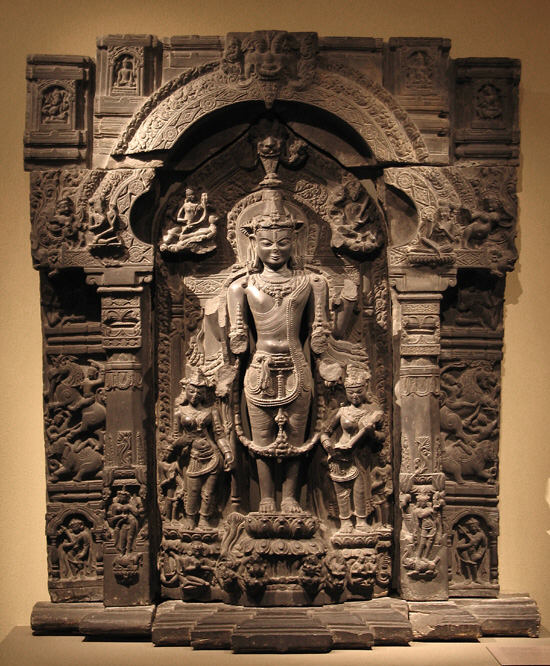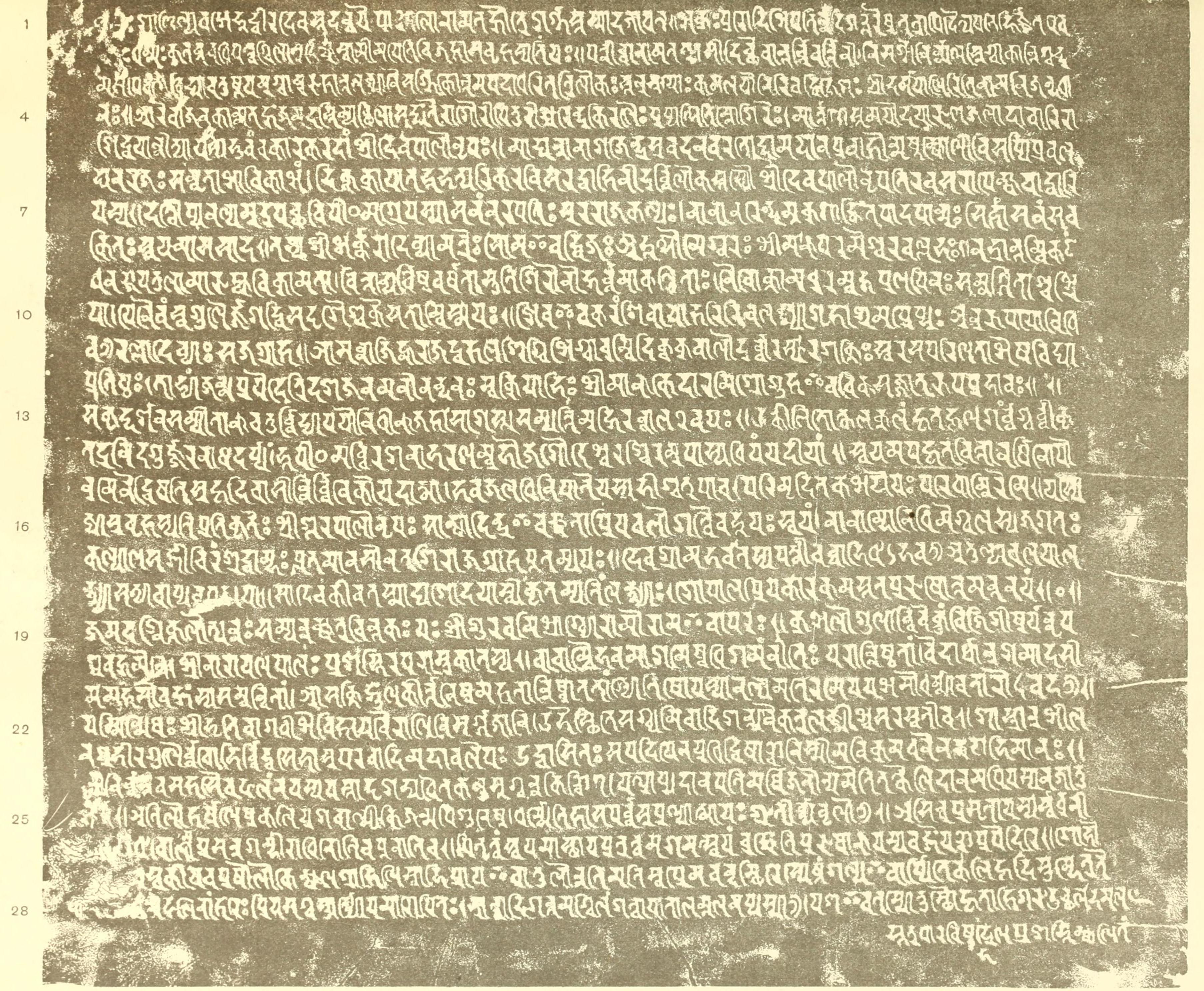|
Gopala II
Gopala II (reigned after 872 CE) was the successor to the Pala king Shurapala I in the Bengal-Bihar region of the Indian subcontinent, and the sixth ruler of the Pala line reigning for at least four years. The existence of this king came to light when, in 1995, historian Gouriswar Bhattacharya discovered two copper plate inscriptions of a previously unknown Pala king in Los Angeles County Museum of Art, where these had been sent for cleaning by a private collector. This king got designated as Gopala II; consequently, existing Gopala II and Gopala III were re-designated as Gopala III and Gopala IV, respectively. The text of these two inscriptions were subsequently edited by Ryosuke Furui in 2009. Life Three copper plate inscriptions of this king have so far been discovered. One was issued in his third regnal year, the other two (the ones discovered in Los Angeles) on the same date in the fourth regnal year. As per these plates, Gopala II was the son of Shurapala I and grandson ... [...More Info...] [...Related Items...] OR: [Wikipedia] [Google] [Baidu] |
Pala Empire
The Pāla Empire (r. 750-1161 CE) was an imperial power during the post-classical period in the Indian subcontinent, which originated in the region of Bengal. It is named after its ruling dynasty, whose rulers bore names ending with the suffix ''Pāla'' ("protector" in Prakrit). The empire was founded with the election of Gopāla as the emperor of Gauda in late eighth century AD. The Pala stronghold was located in Bengal and eastern Bihar, which included the major cities of Gauḍa, Vikramapura, Pāṭaliputra, Monghyr, Somapura, Ramavati ( Varendra), Tāmralipta and Jaggadala. The Pālas were astute diplomats and military conquerors. Their army was noted for its vast war elephant corps. Their navy performed both mercantile and defensive roles in the Bay of Bengal. At its zenith under emperors Dharmapala and Devapala in the early ninth century, the Pala empire extended their dominance into the northern Indian region, with its territory stretching across the Gangetic pl ... [...More Info...] [...Related Items...] OR: [Wikipedia] [Google] [Baidu] |
Mahendrapala I
Mahendrapala I (885–910) was a ruler of Pratihara dynasty, the son of Mihir Bhoja I and queen ''Candra-Bhatta-Rika-Devi''. He was also mentioned on various inscriptions in Kathiawar, Punjab and Madhya Pradesh by names ''Mahindrapala'', ''Mahendrayudha'', ''Mahisapaladeva'', and also ''Nirbhayaraja'' and ''Nirbhayanarendra'' in the plays of Rajasekhara. Reign Inscriptions discovered at Ramgaya, opposite the Gadadhar temple at Gaya, at Guneria in the southern part of the Gaya district, at Itkhori in the Hazaribagh district of Bihar, describe his reign. Earlier, it was thought that the greater part of Magadha up to even northern Bengal had come under the suzerainty of the monarch Mahendrapala I.Sen, S.N., 2013, A Textbook of Medieval Indian History, Delhi: Primus Books, However, that theory has been debunked due to the discovery of a Pala king named Mahendrapala, whose inscriptions were mistakenly attributed to his Gurjara namesake. In north his authority was extended u ... [...More Info...] [...Related Items...] OR: [Wikipedia] [Google] [Baidu] |
List Of Rulers Of Bengal
This is a list of rulers of Bengal. For much of its history, Bengal was split up into several independent kingdoms, completely unifying only several times. In ancient times, Bengal consisted of the kingdoms of Pundra, Suhma, Vanga, Samatata and Harikela. In the 4th century BCE, during the reign of the Nanda Empire, the powerful rulers of Gangaridai sent their forces with the war elephants which led the withdrawal of Alexander the Great from the Indian subcontinent. As a province of the Mauryan Empire, much of Bengal was part of it except for the far eastern Bengali kingdoms which maintained friendly relationships with Ashoka. The kingdoms of Bengal continued to exist as tributary states before succumbing to the Guptas. With the fall of the Gupta Empire, Bengal was united under a single local ruler, King Shashanka, for the first time. With the collapse of his kingdom, Bengal split up into petty kingdoms once more. With the rise of Gopala in 750 AD, Bengal was united ... [...More Info...] [...Related Items...] OR: [Wikipedia] [Google] [Baidu] |
Narayanapala
Narayanapala (9th-10th century CE) was the seventh emperor of the Pala dynasty of the Eastern regions of the Indian subcontinent, mainly the Bengal and Bihar regions. He was the son of Vigrahapala I by his wife, the Kalachuri The Kalachuris (IAST: Kalacuri), also known as Kalachuris of Mahishmati, were an Indian dynasty that ruled in west-central India between 6th and 7th centuries. They are also known as the Heheya Kingdom, Haihayas or as the Early Kalachuris to d ... princess Lajjadevi. He was later succeeded by his son Rajyapala. The Gaya temple inscription dated in his 7th regnal year, the Indian Museum (found in the erstwhile Patna district) stone inscription dated in his 9th regnal year, the Bhagalpur copper-plate grant dated in his 17th regnal year, Bihar votive image inscription dated in his 54th regnal year and the Badal pillar inscription of his minister Bhatta Guravamishra provide information about his reign.Sinha, Bindeshwari Prasad (1977). ''Dynastic His ... [...More Info...] [...Related Items...] OR: [Wikipedia] [Google] [Baidu] |
Naogaon District
Naogaon District ( bn, নওগাঁ, Nôugã) is a district in northern Bangladesh, part of the Rajshahi Division. It is named after its headquarters, the city of Naogaon in Naogaon Sadar Upazila. Demographics According to the 2022 Census of Bangladesh, Naogaon District had a population of 2,784,598, of which 13,74,312 were males and 14,08,840 females. The rural population was 23,67,082 (85.01%) while the urban population was 4,16,243 (14.99%). Naogaon district had a literacy rate of 72.14% for the population 7 years and above: 74.66% for males and 69.70% for females. This is up from 44.39% in 2001 and 28.40% in 1991. Nagaon District had a decadal growth rate of 8.73% for the decade 2001–2011, down from 11.33% in the decade 1991–2001. Muslims make up 86.82% of the population, while Hindus are 11.45% and Christians 0.77% of the population respectively. Other religions were 0.95% of the population. Ethnic minorities were 1,07,292 (3.85%). This was the largest ethnic ... [...More Info...] [...Related Items...] OR: [Wikipedia] [Google] [Baidu] |
Dhamoirhat Upazila
Dhamoirhat ( bn, ধামইরহাট) is an upazila of Naogaon District in the Division of Rajshahi, Bangladesh. The main river of the Dhamoirhat Upazila is the Atrai. History During the War of Liberation, the Pak army had camped at places like Farsipara, Pagla Dewan, Rangamati, etc. A direct encounter between the Pak army and the freedom fighters were held at Piral Danga, Gangra, Kulfatpur and Rangamati with the heavy casualty on both sides. The Pak army burnt and sacked the village Kulfatpur and killed 14 innocent villagers. Marks of War of Liberation Mass grave: 2 (Farsipara, Pagla Dewan). Geography Dhamoirhat is located at . It has 29661 households and total area 300.8 km2. Dhamoirhat Upazila is bounded by Balurghat and Tapan CD Blocks in Dakshin Dinajpur district, West Bengal, India, on the north, Joypurhat Sadar Upazila on the east, Badalgachhi and Patnitala Upazilas on the south and Patnitala Upazila on the west. Climate Dhamoirhat is placed in a monsoon are ... [...More Info...] [...Related Items...] OR: [Wikipedia] [Google] [Baidu] |
Gauda Kingdom
The Gauḍa Kingdom (Gāuṛ Rājya) or Shashankas, was a classic kingdom during the Classical period on the Indian subcontinent, which originated in the region of Bengal (modern-day West Bengal and Bangladesh) in 4th century CE or possibly earlier. Location and extent A Buddhist Mahāyāna Text Mañjuśrī-Mūlakalpa records the existence of Gauda Kingdom in Bengal before it was replaced by Gupta Empire in the 4th century. King Loka who was born in Vardhamāna ( Bardhamān) is mentioned who must have ruled in the early 4th century CE. King Shashanka is often attributed with creating the first separate political entity in a unified Bengal called Gauda. He reigned in 7th century, and some historians place his rule approximately between 590 and 625. His capital was at Karnasubarna, south-west of Baharampur, headquarters of Murshidabad district. The Chinese monk, Xuanzang (Hiuen Tsang) travelled from the country of Karnasubarna to a region in the present-day state of Oriss ... [...More Info...] [...Related Items...] OR: [Wikipedia] [Google] [Baidu] |
Regnal Year
A regnal year is a year of the reign of a sovereign, from the Latin ''regnum'' meaning kingdom, rule. Regnal years considered the date as an ordinal, not a cardinal number. For example, a monarch could have a first year of rule, a second year of rule, a third year of rule, and so on, but not a zeroth year of rule. Applying this ancient epoch system to modern calculations of time, which include zero, is what led to the debate over when the third millennium began. Regnal years are "finite era names", contrary to "infinite era names" such as Christian era, Jimmu era, ''Juche'' era, and so on. Early use In ancient times, calendars were counted in terms of the number of years of the reign of the current monarch. Reckoning long periods of times required a king list. The oldest such reckoning is preserved in the Sumerian king list. Ancient Egyptian chronology was also dated using regnal years. The Zoroastrian calendar also operated with regnal years following the reform of Ar ... [...More Info...] [...Related Items...] OR: [Wikipedia] [Google] [Baidu] |
Shurapala I
Shurapala I (also spelt Surapala) was a 9th-century ruler of the Pala Empire, in the Bengal region of the Indian subcontinent. He was the fifth Pala emperor. He ruled for at least 12 years. Ancestry Previously, the historians believed that Shurapala and Vigrahapala were the two names of the same person. However, the discovery of a copper plate in 1970 in the Mirzapur district conclusively established that these two were cousins. They either ruled simultaneously (perhaps over different territories) or in rapid succession. If they ruled in succession, it seems more likely that Shurapala preceded Vigrahapala, since Vigrahapala I and his descendants ruled in unbroken succession. Vigrahapala either dethroned Shurapala, or replaced him peacefully in absence of any direct heir to the throne. Earlier, it was believed that Shurapala and Vigrahapala succeeded Devapala. However, the discovery of a copper plate charter at Jagjivanpur indicates that Shurapala was preceded by Mahendrapala ... [...More Info...] [...Related Items...] OR: [Wikipedia] [Google] [Baidu] |


.png)

